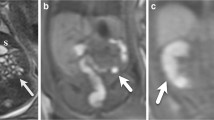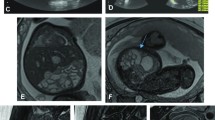Abstract
Background
Prenatal small-bowel obstruction can result from single or multiple atresias, and it can be an isolated abnormality or part of a syndrome. It is sometimes the first manifestation of cystic fibrosis. Accurate prediction of the level of obstruction and length of bowel affected can be difficult, presenting a challenge for counseling families and planning perinatal management.
Objective
To review the prenatal US and MRI findings of small-bowel obstruction and to assess whether fetal MRI adds information that could improve prenatal counseling and perinatal management.
Materials and methods
We retrospectively reviewed 12 prenatally diagnosed cases of small-bowel obstruction evaluated by both US and MRI from 2005 to 2015. We analyzed gestational age at evaluation, US and MRI findings, gestational age at delivery and postnatal outcomes.
Results
The final diagnoses were jejunal atresia (7), ileal atresia (1), cystic fibrosis (3) and combined jejunal and anal atresia (1). Four of the eight with jejunal atresia were found to have multiple small-bowel atresias. Prenatal perforation was noted in three. We identified a trend of increasing complexity of bowel contents corresponding to progressively distal level of obstruction, as indicated by increasing US echogenicity and high T1 signal on MRI. Seven cases of jejunal atresia and one case of ileal atresia demonstrated small ascending, transverse and descending colon (microcolon) with filling of a normal-diameter rectum. In contrast, all three fetuses with cystic fibrosis and the fetus with jejunal–anal atresia demonstrated microcolon as well as abnormal paucity or absence of rectal meconium. Polyhydramnios was present in nine. Eight were delivered prematurely, of whom seven had polyhydramnios. The fetus with jejunal and anal atresia died in utero. Postnatally, three had short gut syndrome, all resulting from multiple jejunal atresias; these three were among a subset of four fetuses whose bowel diameter measured more than 3 cm. Eight infants had no further gastrointestinal complications. The presence of multiple atresias was not predicted by prenatal US or MRI.
Conclusion
MR provides useful additional information regarding meconium distribution in the small bowel, which helps to clarify the level of obstruction. MR was additionally useful in the assessment of colon and rectal contents, serving as a fetal enema. Abnormally diminished meconium in the rectum suggests cystic fibrosis or combined small-bowel and colonic obstruction, information that is useful in counseling and preparing for postnatal care.









Similar content being viewed by others
References
Reyes HM, Meller JL, Loeff D (1989) Neonatal intestinal obstruction. Clin Perinatol 16:85–96
Barnewolt CE (2004) Congenital abnormalities of the gastrointestinal tract. Semin Roentgenol 39:263–281
Wax JR, Hamilton T, Cartin A et al (2006) Congenital jejunal and ileal atresia: natural prenatal sonographic history and association with neonatal outcome. J Ultrasound Med 25:337–342
Haeusler MC, Berghold A, Stoll C et al (2002) Prenatal ultrasonographic detection of gastrointestinal obstruction: results from 18 European congenital anomaly registries. Prenat Diagn 22:616–623
Baglaj M, Carachi R, Lawther S (2008) Multiple atresia of the small intestine: a 20-year review. Eur J Pediatr Surg 18:13–18
John R, D’Antonio F, Khalil A et al (2015) Diagnostic accuracy of prenatal ultrasound in identifying jejunal and ileal atresia. Fetal Diagn Ther 38:142–146
Veyrac C, Couture A, Saguintaah M et al (2004) MRI of fetal GI tract abnormalities. Abdom Imaging 29:411–420
Colombani M, Ferry M, Garel C et al (2010) Fetal gastrointestinal MRI: all that glitters in T1 is not necessarily colon. Pediatr Radiol 40:1215–1221
Huisman TA, Kellenberger CJ (2008) MR imaging characteristics of the normal fetal gastrointestinal tract and abdomen. Eur J Radiol 65:170–181
Rubesova E (2012) Fetal bowel anomalies — US and MR assessment. Pediatr Radiol 42:S101–S106
Saguintaah M, Couture A, Veyrac C et al (2002) MRI of the fetal gastrointestinal tract. Pediatr Radiol 32:395–404
Tonni G, Grisolia G, Granese R et al (2015) Prenatal diagnosis of gastric and small bowel atresia: a case series and review of the literature. J Matern Fetal Neonatal Med 23:1–9
Naritaka N, Suzuki M, Sato H et al (2015) Profile of bile acids in fetal gallbladder and meconium using liquid chromatography-tandem mass spectrometry. Clin Chim Acta 446:76–81
Rubesova E, Vance CJ, Ringertz HG et al (2009) Three-dimensional MRI volumetric measurements of the normal fetal colon. AJR Am J Roentgenol 192:761–765
Jerdee T, Newman B, Rubesova E (2015) Meconium in perinatal imaging: associations and clinical significance. Semin Ultrasound CT MR 36:161–177
Sciarrone A, Teruzzi E, Pertusio A et al (2016) Fetal midgut volvulus: report of eight cases. J Matern Fetal Neonatal Med 29:1322–1327
Author information
Authors and Affiliations
Corresponding author
Ethics declarations
Conflicts of interest
None
Rights and permissions
About this article
Cite this article
Rubio, E.I., Blask, A.R., Badillo, A.T. et al. Prenatal magnetic resonance and ultrasonographic findings in small-bowel obstruction: imaging clues and postnatal outcomes. Pediatr Radiol 47, 411–421 (2017). https://doi.org/10.1007/s00247-016-3770-0
Received:
Revised:
Accepted:
Published:
Issue Date:
DOI: https://doi.org/10.1007/s00247-016-3770-0




